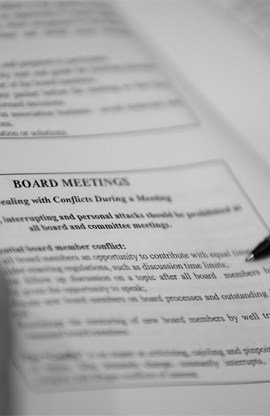At this time of year, just around the holidays, questions regarding annual meetings fill our “First Friday” phone lines. Yes, your Board must conduct an Annual Meeting! Under Arizona law, A.R.S. Section 33-1804(B) and 33-1248(B) an association must conduct an annual meeting of its membership at least once a year. An annual meeting requires planning and execution to make it successful. Set forth below are some tips to help your association conduct a “flawless” annual meeting.
- Check the governing documents for any special annual meeting and voting requirements (such as secret ballot) and plan accordingly. Typically, an association’s bylaws will set forth the requirements of an annual meeting including the plate, quorum and voting.
- Set up an efficient registration system prior to the members arrival. Set up an appropriate number of registration tables and make signs that assign a portion of the alphabet to each table (for example, A-H, IO, P-Z). A registrar should be assigned to each table and the member rosters should be divided according to the tables so that the registrars will only work with those names that are in their section of the alphabet.
- Have an accurate roster of owners. Under Arizona law, an association has a duty to keep an accurate roster of owners and their current addresses. This membership list should be updated and complete for the annual meeting.
- Bring a laptop with internet access to provide the most up-to-date ownership information when members are registering and questions arise. The Maricopa County Assessor’s Office website will help you tremendously.
- Publicize and conduct sign-in and a “social time” 30 to 60 minutes prior to the start of the meeting and request that owners come early to sign in.
- Have a greeter at the door to welcome and direct members.
- Have association governing documents available (so that questions can be accurately answered).
- Appoint a troubleshooter. There will always be unexpected events during registration at an annual meeting. Therefore, a troubleshooter (with no other responsibilities) should be designated by the board to handle anything out of the ordinary (such as questions about ownership, right to vote and delinquent owners).
- Provide ample sign-in materials. Determine what registration materials are needed (roster, sign-in sheets, handouts, pens, pencils and ballots), how many copies are required and prepare them in advance.
- Have a plan to distribute materials in an orderly fashion. Assign a person to distribute materials at check-in. If you have several things to hand out, creating a packet of materials that can easily be handed to people as they check in assures that each person gets all the necessary materials.
- The board should appoint several independent “inspectors of election” to oversee the voting and elections. Their duties are to tabulate and record the votes on the formal tally sheets created for the expressed purpose of capturing the votes. At least one of the inspectors should be from the opposing side if there are factions at the annual meeting. However, no one should be an inspector who may have an interest in the election results (such as candidates, candidate’s spouses, current officers, directors or the management company). Count ballots with one group of inspectors and re-count, if necessary, with a different group. If the association’s attorney is present, the attorney also helps oversee this process.
- The association must first obtain a quorum (a minimum number of owners present in person or by mail in/absentee ballot) to lawfully conduct business at an annual meeting. The number of members needed to constitute a quorum is almost always indicated in the association bylaws. Arizona law provides a default quorum of ten percent if the association’s documents are silent regarding a quorum.
- Look at your governing documents prior to the annual meeting for guidance regarding whether nominations from the floor are allowed at an annual meeting.
- The president should:
- Start the annual meeting promptly at the designated time
- Conduct the meeting by following the agenda
- Act in a business-like manner
- Use parliamentary procedure to ensure that the meeting moves along quickly
- Consider a homeowner’s forum at the end of the meeting or when the ballots are being counted by the inspectors of election. This allows time for homeowners to comment on aspects of association life. Limit homeowner comment time to 1-3 minutes per owner depending on the number in attendance. You can ask those wanting to speak to sign in to determine how much time will be needed for the forum.
To learn more about annual meetings review our Mulcahy Community Association Cheat Sheet, How to Conduct a Successful Annual Meeting.
